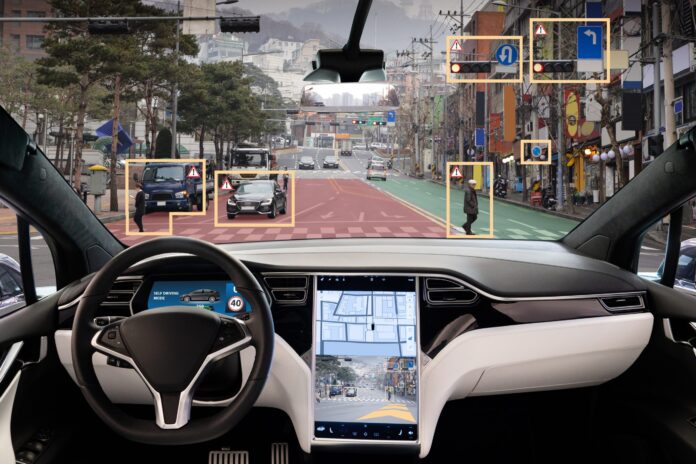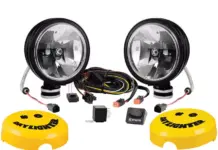Author: Sean Tucker
Date Published: 8/03/2021
Publisher: Kelley Blue Book
Link: https://www.kbb.com/car-advice/self-driving-cars/
This guide will walk you through what you need to know about automotive autopilot, self-driving technology, and driver aids today and tomorrow.
What is a Self-Driving Car?
From engineering jargon to marketing speak, the lingo continues to evolve in this field. Roughly speaking, you can sort the technologies people might refer to as self-driving into two categories — driver support and automation systems.
Driver Support
Driver support technology reduces the workload on the driver. Today, most automakers sell various driver support systems, either as standard equipment or as options on their cars. These include intelligent or adaptive cruise control, lane-keeping assists, and hands-free capability.
Autonomous Systems
Autonomous systems do the driving for you. No automaker today sells a true autonomous system, but some are pushing toward that technology. One such project underway is Waymo, a sister company to Google, that is testing autonomous rideshare vehicles in Phoenix using converted Chrysler Pacifica minivans.
Six Levels of Self-Driving Technology
SAE International, a global association of engineers and related technical experts in the aerospace, automotive, and commercial-vehicle industries, has laid out a useful framework for thinking about self-driving systems. They sort the technologies into six levels, labeled zero through five.
However, not every level is classified as autonomous driving. According to SAE, levels zero through two are considered driver support features, while levels three through five are classified as having autonomous capability.
Level 0
At Level 0, the car reacts only to the driver’s input. Even if it uses sensors to warn you of surrounding traffic, like a blind-spot alert system or a lane-departure warning, it still has no self-driving capability to correct or counter the perceived threat.
Level 1
At Level 1, your car can intervene slightly in your driving in an attempt to keep you safe. A lane-keeping system that helps steer to center you in a lane is a Level 1 technology.
Level 2
At Level 2, features communicate with one another, and more than one can be active simultaneously. An example of this autonomous technology is an adaptive cruise control system that adjusts your speed to keep you a certain distance from the car ahead while centering the car in its lane.
Currently, Level 2 systems are the most sophisticated technology sold on cars in America. Some automakers describe these systems in ways that make them seem more advanced than Level 2 standards because they allow drivers to take their hands off the steering wheel briefly.
However, all these systems require drivers to keep their eyes focused ahead. Drivers need to be ready at all times to take over control of the car at a moment’s notice.
Level 3
At Level 3, the car can drive itself under limited conditions, but the driver must remain aware and prepared to take over. Automakers have tested Level 3 systems that will allow the driver to take their hands off the wheel in a traffic jam, for instance, but prompt the driver to take over when the congestion eases.
According to Honda and a few other reputable sites, the Honda 100 Legend Flagship car is the first Level 3 autonomous car. Right now, it’s only available in Japan for leasing. It was released on March 5, 2021.
There are no Level 3 systems currently sold to consumers in the U.S.
Level 4
At Level 4, the car can drive itself in a fixed loop on known roads. The rider is not required to take over driving at any time. These vehicles may or may not have a steering wheel or pedals. In some places, Level 4 driverless rideshare vehicles (like Waymo’s) are in limited testing. But they are not yet approved for general use in any state.
Level 5
At Level 5, the car can drive itself under any conditions and on any road. These vehicles do not have steering wheels or pedals. At this point, Level 5 systems are theoretical.
Do You Still Need to Pay Attention to the Road?
Yes. Always. Even when using driving assist technology in Levels 0 to 3, it’s required that you always keep your eyes on the road.
However, when using low-speed applications, including self-parking features, keeping your eyes on the road or staying inside the vehicle may not be needed. For example, some luxury brands offer a self-parking remote that handles this maneuver for things like parallel parking.
Which Cars Have Self-Driving Capability?
Virtually every automaker selling cars in the U.S. today offers driver-assistance systems that can reduce the workload on the driver. These include adaptive cruise control that can adjust speed to maintain distance from the car ahead or automatic emergency braking that can slow or stop the car to avoid hitting a vehicle or pedestrian or reduce the severity of a crash.
None of these systems are so reliable that the driver can take their attention from the task of driving, though.
Many manufacturers currently market systems up to and including Level 2 automation. This approach combines adaptive cruise control and lane-keeping assist into a system that requires that the driver keep their hands on the wheel but relieves some of the driver’s workload.
A prime example is cruise control with stop-and-go capability that allows the driver to negotiate heavy traffic without using the pedals.
The Future of Self-Driving Cars
Engineers from more than a dozen companies are testing self-driving systems in hopes of producing an SAE Level 5 self-driving car. It seems safe to predict that the technology is coming.
But the engineering challenge of getting there is immense. A car that can drive itself on well-maintained roads may make a critical mistake on poorly maintained roads. What if a car that can react safely to normal traffic may not react safely to unusual situations? A car that can do everything engineers ask of it may fail when presented with a problem they never considered (in one recent incident, a self-driving car in testing was baffled by a truck bed full of traffic signs being delivered to a construction site. The car had no idea what to do).
Beyond the engineering challenge, 50 sets of state laws (plus the District of Columbia) must adapt to decide safety and liability issues before self-driving cars can become common.
The market will also have its say. Volkswagen recently unveiled a concept car that would charge by the mile for self-driving capability. Executives reasoned that as long as getting your car to drive you somewhere costs less than a train ticket to that same place, they could charge for using the self-driving feature. So, while some automakers hope to charge buyers upfront for automation, others may make it available for short-term rental only.
Lastly, there’s the matter of marketing. It’s already growing difficult to sort what manufacturers claim their cars can do from what they can actually do. That will only grow cloudier as the technology advances.
So, while you may be able to own a self-driving car in your lifetime, it may be further away than advancing technology would indicate.
This article will likely be one of the more important ones in the dossier, as it provides a significant amount of information related to the levels of autonomy currently assigned to vehicle, and what each respective one means. With this understanding, we can successfully determine the level of autonomy that our vehicle seat design is going into, and can design according to user needs more successfully; for example, a solution for a level 2 vehicle could look drastically different from a level 5, so we need to take this specifically defined terminology into consideration.
Additionally, this article poses several jarring questions about the future of autonomous vehicles, and problems that can arise when they aren’t designed and engineered correctly. Understanding this will help us better understand the feelings of the user and will help us design a better transitional space that could lead to a better acclimation experience to autonomous vehicles released in the future.
Tucker, S. (2021, August 3). Self-Driving Cars: Everything You Need to Know. Retrieved September 22, 2021, from https://www.kbb.com/car-advice/self-driving-cars/.




